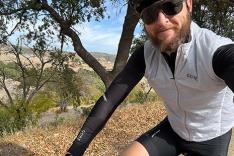What is a cyclist to do? Well, the good news is that there are many excellent and motivating instructors out there who do ride a real bike and bring their outdoor experiences indoors.
You may have to do some searching and try different instructors. If you can't find the perfect cyclist-coach combination but you find someone you enjoy who motivates you, the rest is up to you. Remember, indoor cycling is all about taking responsibility for your own training. No one else is forcing you to do anything you don't want to do.
When you first start looking for a class, ask the fitness director which instructors are outdoor cyclists, and let them know you are looking for classes that refrain from aerobics-on-a-bike techniques (known in the industry as "contraindications" in indoor cycling). Inquire whether they require all their instructors to maintain their certifications. While this is not a guarantee of quality, it is at least a first step.
Try out several classes. You may find an instructor who provides a fun and effective workout, but perhaps the intensity is too high all the time or she changes positions a little too often for your tastes or current training needs. Just sit in the saddle, ride your own ride and decide not do those movements.
The following are the potential benefits that can be achieved through proper training indoors in cycling classes. You simply have to train these elements of your cycling fitness the same way you would train them outdoors or on your trainer: intelligently, with the right gear (resistance) and realistic cadences. In general, cadence ranges of 55-85 would indicate a hill, and 75-110 rpm would indicate a flat road. (Note that the cadence suggestions and durations below are approximate ranges for the general population—there are always exceptions based on ability).
- Aerobic endurance: Best enhanced with sessions longer than one hour
- Tempo workouts: Moderate 90-100 rpm in Zone 3 -- the zen of indoor cycling!
- Muscular endurance: Climbs focusing on repeatedly contracting against a resistance gradually maintaining the climb for longer and longer periods, 65-85 rpm.
- Force development: Higher resistance climbs of 55-65 rpm (50 rpm advisable only for cyclists who have already established excellent strength)
- Lactate threshold improvement: Probably one of the best ways to utilize your indoor cycling classes is to train your lactate threshold through longer Zone 4 intervals. Sparingly, that is.
- Anaerobic endurance: High intensity interval training of 1-3 minutes.
- Aerobic capacity/VO2 max: "Sufferfest" anaerobic Zone 5 intervals of 3-8 minutes
- Anaerobic Capacity: Very high intensity Zone 5 intervals of about 15-60 seconds.
- Neuromuscular/Leg Speed: While the neuromuscular adaptations are limited due to the fact that most bikes have a heavy flywheel pulling the pedals around, you can still train your leg speed if you make sure to stay ahead of the flywheel and to have sufficient resistance. Cap your leg speed drills indoors on a bike with a flywheel at 110 rpm, perhaps up to 120 rpm for skilled cyclists. Work on spin-ups and accelerations against a resistance.
- Explosive Power (Sprinting): Be very careful with these. Most instructors and students do not know a true sprint. Duration is less than 30 seconds and resistance is high. Do not do these except in the spring as you approach your cycling season.
- Technique: Classes are a fantastic place to work on pedal stroke drills, keeping the knees in, and upper body relaxation while riding.
- Mind-Body Focus: Visualize your favorite rides outside. Establish your mental strength and tenacity indoors, so you can transfer it to your rides outdoors. Indoors is a wonderful venue to work on your mind-body focus, and is facilitated with the right (usually instrumental) music that can transform you to another place.
- Recovery Rides: An indoor cycling class is a great place to spin your legs easily the day after a hard workout. Keep the intensity low .
- 3
- of
- 4








Discuss This Article